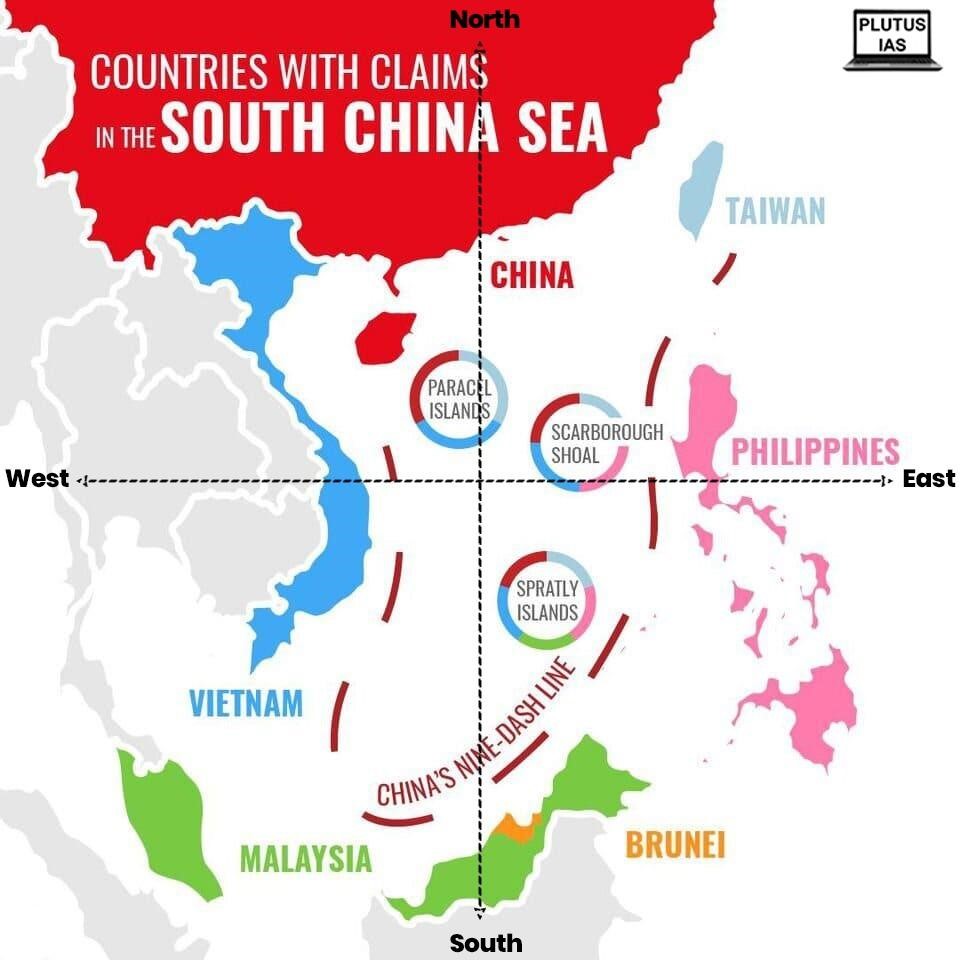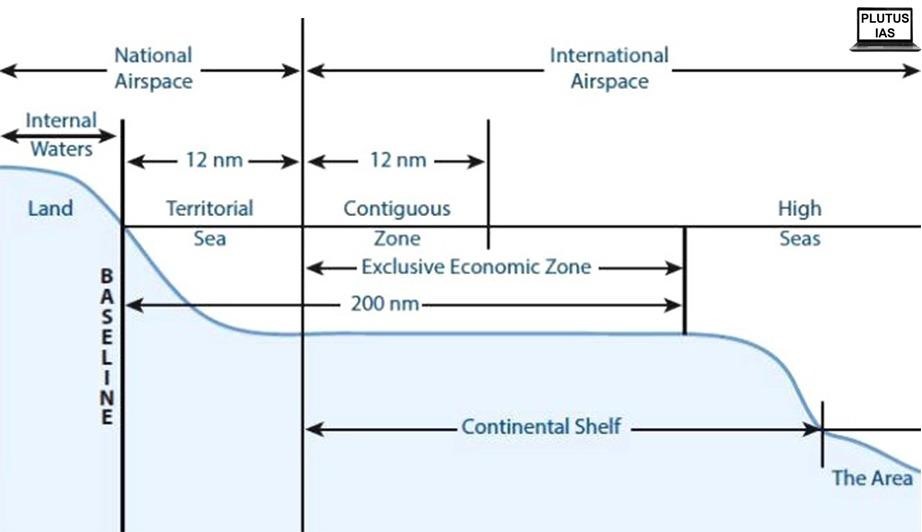22 Feb South China Sea Conflict
South China Sea Conflict
This article covers “Daily current events “and the topic is about the ‘South China Sea Conflict’ which is in news, it covers “International Relations” In GS-2, the following content has relevance for UPSC.
For Prelims: South China Sea Geographical location
For Mains: GS-2, International Relations
Why in the news: Chinese Coast Guard vessel hits Filipino crew with laser light in South China Sea
About South China Sea
The South China Sea is one of the busiest waterways in the world and is famously known for trade and merchant shipping. The sea Disputes are maritime and island claims between different sovereign countries in the region. These countries are China, Taiwan, Vietnam, Malaysia, Philippines, and are geopolitically located in the Indo-Pacific region.

South China Sea
Historical Background
- During World War II, the Imperial Japanese Army and Navy had used several islands for military reasons and stated that these islands were unclaimed, despite historical records that showed.
- Before the Japanese took control of their colonial possessions, France held jurisdiction over some of the islands.
- Upon the end of the war, the 1951 Treaty of San Francisco forced Imperial Japan into giving up any territory they had conquered during the war.
- The People’s Republic of China made various claims to the islands during the 1951 treaty negotiations.
- Chinese claims in the south china sea are described in part by the nine-dash line. Originally an “eleven-dashed-line,” this line was first indicated by the Kuomintang government of the Republic of China in 1947, for its claims to the South part of the Sea.
- The Paracels and Spratly Islands were included in the Vietnamese regions south of the 17th Parallel that were under South Vietnam’s authority as a result of the Geneva Accords of 1954, which put an end to the First Indochina War.
- Two years later the North Vietnamese government claimed that the People’s Republic of China is the lawful claimant of the islands, while South Vietnam took control of the Paracel Islands.
Significance of the South China Sea
- Natural Resources: The Sea is said to be a major source of natural resources for the different territories. About 10% of the nation’s fisheries come from there, making it a vital source of food for hundreds of people. This is also a major reason why people from different countries are claiming their rights over the sea.
- Trade Route: The route passing through it, Malacca Strait is home to 55% of the trade. It is one of the busiest routes for trade.
Reasons for the Dispute
- Claims over Islands: China’s Nine Dash Line – claiming the largest portion of the Sea.

Reasons for Dispute in the Sea
- China’s Assertion:
- China has been converting uninhabited islets into artificial islets i.e “great wall of sand” to bring it under UNCLOS.
- China established airstrips on Parcel and Spratly.
- China continues coast guard targeting vessels with military-grade laser
- Instead of fishing, Chinese fishing boats are involved in paramilitary activities.
- Additional Facts:
UNCLOS: United Nations Convention on the Law of the sea also known as the Law of the Sea Convention or the Law of the Sea Treaty.
-
- Adopted in 1982.
- Divided into Maritime Zones:
- Internal Water – Bays, Ports, Inlets, Rivers, and lakes.
- Territorial Sea – up to 12 nautical miles
- Contiguous Zone – up to 24 nautical miles
- Exclusive Economic Zone – up to 200 nautical miles
- High Seas – the common heritage of all mankind

Additional Facts of the Sea disputes
Other Major Issues
- The undefined geographic scope of the South China Sea.
- Disagreement over dispute settlement mechanisms.
- The Code of Conduct’s position under the law is unclear.
- Uninhabited archipelagos make matter more complicated and multifaceted.
Response of Countries Towards Rising Aggression in the South China Sea
- The countries like Vietnam, the Philippines, and Indonesia wants political insurance, strengthen their navies and deepen military relations, and avoid a direct military confrontation with China owing to their economic ties with China.
- Vietnam has added six-kilo class Russian-origin submarines to its navy. India has also provided Brahmos to Vietnam.
- The Philippines wrote to the UN secretary-general on the violation of Filipino sovereignty. Same with Indonesia.
Impact on India due to the South China Sea dispute
- India’s more than 50% of the trade passes through the Strait of Malacca which opens into the Sea.
- If China controls the region, it can hamper India’s foreign trade passing through that region.
- Ensuring freedom of navigation is also important for India’s energy needs.
India’s Stand
- Protect your own economic interests, particularly your need for energy security.
- India has started internationalizing disputes in the Indo-Pacific region to oppose China’s threatening tactics in the South China Sea. The Key element is Act East Policy in this direction.
- Use Soft Power – Using India’s Buddhist legacy to make a strong bond with the South East Asian Region.
- In order to defend maritime lanes of communication (SLOC) and counteract Chinese aggressiveness in the area, India has stationed its navy in the Sea alongside Vietnam.
Way Forward
- In order for regional stability to thrive and be recognized by all, it is crucial to uphold and encourage peace, stability, and development in the South China Sea region.
- At the same time, bigger countries in the region should be mindful of the views of their smaller neighbors and mediate to find peaceful solutions.
- The other nations should volunteer to act as mediators and should push the ASEAN group nations to hold talks with China and Taiwan, the two non-ASEAN nations, to resolve the issue.
Source:
Download the PDF now
PLUTUS IAS CURRENT AFFAIRS 22th FEB 2023
Daily Current Affairs for UPSC
The topic described above is based on the Relationship between India and China. It reflects the South China Sea disputes that are included under the latest national and international current affairs for the UPSC examination. Get such kinds of the best daily current affairs for the UPSC Examination from Plutus IAS. Also, read weekly and monthly current affairs for the IAS exam preparation.




No Comments